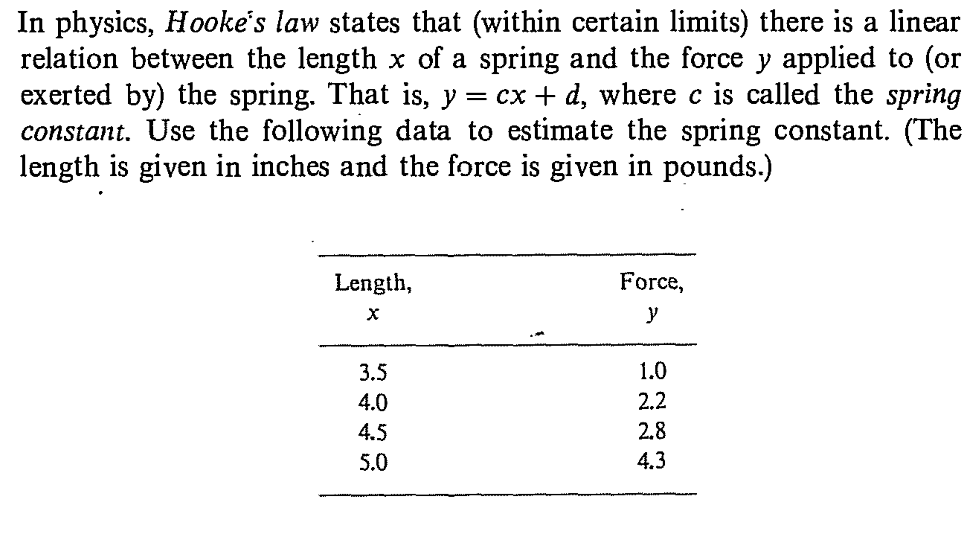In physics, Hooke's law states that (within certain limits) there is a linear relation between the length x of a spring and the force y applied to (or exerted by) the spring. That is, y = cx + d, where c is called the spring constant. Use the following data to estimate the spring constant. (The length is given in inches and the force is given in pounds.) Length, Force, y 1.0 3.5 2.2 4.0 2.8 4.5 4.3 5.0
In physics, Hooke's law states that (within certain limits) there is a linear relation between the length x of a spring and the force y applied to (or exerted by) the spring. That is, y = cx + d, where c is called the spring constant. Use the following data to estimate the spring constant. (The length is given in inches and the force is given in pounds.) Length, Force, y 1.0 3.5 2.2 4.0 2.8 4.5 4.3 5.0
Algebra & Trigonometry with Analytic Geometry
13th Edition
ISBN:9781133382119
Author:Swokowski
Publisher:Swokowski
Chapter8: Applications Of Trigonometry
Section8.3: Vectors
Problem 60E
Related questions
Question

Transcribed Image Text:In physics, Hooke's law states that (within certain limits) there is a linear
relation between the length x of a spring and the force y applied to (or
exerted by) the spring. That is, y = cx + d, where c is called the spring
constant. Use the following data to estimate the spring constant. (The
length is given in inches and the force is given in pounds.)
Length,
Force,
y
1.0
3.5
2.2
4.0
2.8
4.5
4.3
5.0
Expert Solution
This question has been solved!
Explore an expertly crafted, step-by-step solution for a thorough understanding of key concepts.
This is a popular solution!
Trending now
This is a popular solution!
Step by step
Solved in 2 steps with 2 images

Recommended textbooks for you

Algebra & Trigonometry with Analytic Geometry
Algebra
ISBN:
9781133382119
Author:
Swokowski
Publisher:
Cengage

Linear Algebra: A Modern Introduction
Algebra
ISBN:
9781285463247
Author:
David Poole
Publisher:
Cengage Learning

Algebra & Trigonometry with Analytic Geometry
Algebra
ISBN:
9781133382119
Author:
Swokowski
Publisher:
Cengage

Linear Algebra: A Modern Introduction
Algebra
ISBN:
9781285463247
Author:
David Poole
Publisher:
Cengage Learning